Bird Sightings
18th-25th October - Raptors and seabird passage
This week produced an increase of raptors across the Island, presumably following the passerine passage, with a high count of 22 small raptors on the 22nd. This included a record day high count of 7 Merlin, along with 8 Kestrel, 5 Peregrine and 2 Sparrowhawk. A juvenile Hobby was seen on the 19th and 20th on Ackland Moor and Pondsbury Heath. Single Marsh and Hen Harriers were spotted on the 18th and 19th respectively. A Short-eared Owl was present from 18th-21st, largely hunting around the Pondsbury area, but also noted to venture as far down the Island as Barton Field on the 21st.
Thrush migration has been evident through the island all week, with maximum counts of 254 Redwing on the 23rd. Fieldfare numbers have gradually been decreasing throughout the week with a count of 51 on the 18th. Ring Ouzel were spotted on the 18th, 19th and 21st with a maximum count of 3. A single Mistle Thrush was observed on the 21st. Low numbers of Song Thrush have also been present most of the week.
Chaffinch movement has been high this last week with 5064 on the 18th and hundreds logged moving through almost every day. A varied accompaniment of other Finch species were also observed through the week, with 5 Brambling on the 18th, 1 on the 21st, 4 on the 22nd and 3 on the 23rd. Redpoll were seen on the 18th, 19th and 25th, with a high count of 4 on the 25th. Siskin passage was evident throughout the week with 81 birds observed on the 18th and at least a few individuals every day except the 25th. Reed Bunting were seen on the 18th, 21st, 22nd and 25th, with the high count of 4 on the 22nd. A Lapland Bunting was seen passing overhead on the 22nd and Snow Bunting were present between the 20th-24th with up to 5 seen.
Other passerine migrants this past week have included a Yellow-browed Warbler on the Terrace on the 21st, a Garden Warbler and Lesser Whitethroat on the 20th and a Pied Flycatcher on the 21st. A Common Redstart was observed on the 21st on the Terrace and Black Redstart on the 18th-22nd with just one present every day except the 22nd which produced 2 records. At least 1 Treecreeper was on the Island all through the week with observations most days and a new individual noted on the 23rd. Wheatear sightings occurred between the 19th-22nd, White Wagtail were seen on the 20th and 21st and Grey Wagtail passage continued with low numbers seen most days. Hirundine movement continued this week, with Swallows present throughout the week. Numbers are significantly slowing now, however, with single figures since the 23rd. Likely the last sightings of the year for House and Sand Martin occurred with 3 on the 18th and 2 on the 21st respectively.
A Glossy Ibis was spotted passing the Island far out to sea on the 18th. Up to 4 Water Rail have been encountered on a daily basis. Wader species present this week have included a Curlew passing on the 21st, Woodcock on the 19th-21st and 23rd, and Snipe every day, reaching a maximum count of 9 on the 23rd. Jack Snipe have also been seen, with 2 on the 19th although a marked reduction this week compared to the last.
Seabird passage has been building all week with large feeding frenzies spotted regularly off the island. Kittiwake and Auk numbers have been rising through the week reaching highs of 641 on the 24th and 966 on the 25th respectively. Gannet numbers reached 96 on the 19th and while still present every day, have gradually decreased. Up to 23 Manx Shearwater have been seen most days also. Other seabirds have included Cormorant on the 20th and 22nd, Black-headed Gull on the 23rd and 24th and Common Gull on the 18th, 20th, 21st and 23rd with a high count of 8.
14-17th October - Olive-backed Pipit and 20 Jack Snipe
Persistent moderate easterlies. Mostly overcast, but a day of bright sun on 16th.
12 Teal flew into Pondsbury on 14th, although only five have stuck around. Mallard high count has been 19. Remarkably a Goosander flew south along the east coast on 15th, seen by a single observer and becoming the third island record, with other records in December 1934 and November 2020. We have just one Woodpigeon recorded daily, plus a single Feral Pigeon on 16th and two on 17th. Five Water Rail were recorded on 16th, a good high count with 3 in Millcombe and 2 at Pondsbury.
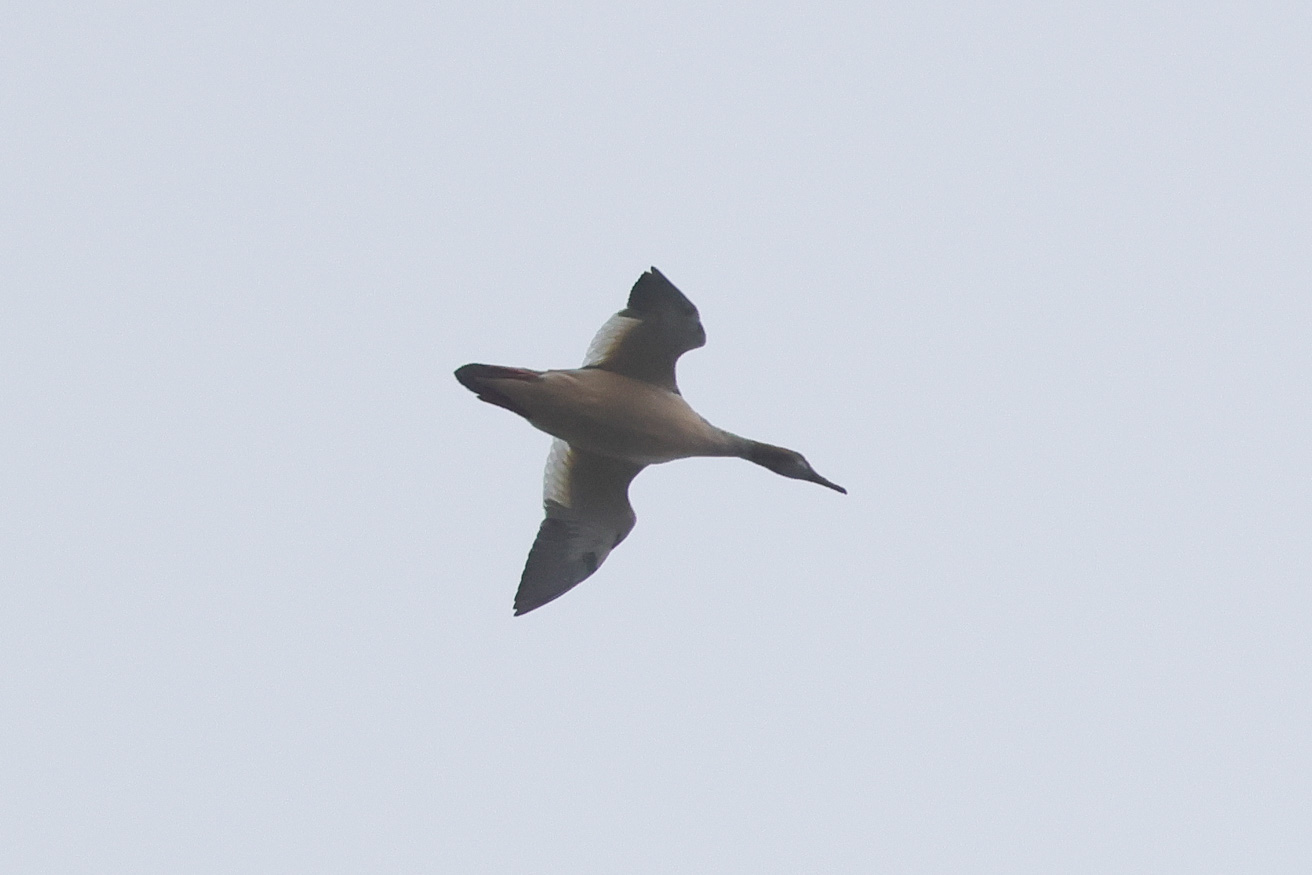 Flyover Goosander from the Terrace - A. Croudace
Flyover Goosander from the Terrace - A. Croudace
Three Lapwing arrived on 14th and a fourth joined them touring the island on 15th. Golden Plover and Ringed Plover continue to be recorded as singles. High count of Oystercatcher of 25 on 14th. A single Dunlin flew from Pondsbury on 16th. The first Woodcock of 2025 was recorded on 14th above Pilot's Quay, with another on 16th in Gannets Coombe. Most notably a record breaking total of 20 Jack Snipe on 16th is the highest ever day count, smashing the previous day record of 11 from October 1984. Common Snipe counts have peaked at just eight, significantly outnumbered by their smaller relatives.
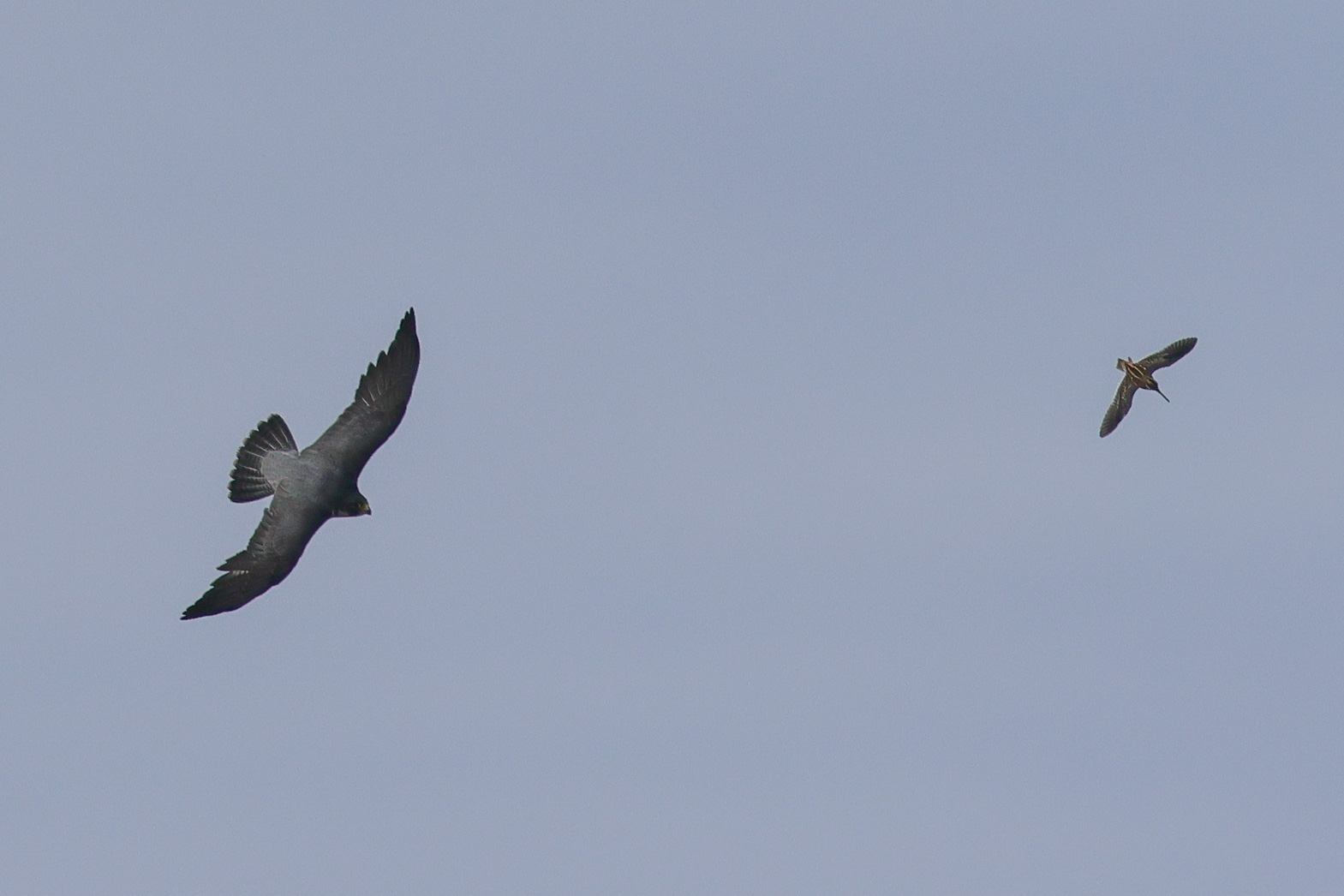 Peregrine Falcon unsuccessfully chasing one of the many Jack Snipe on the island at the moment A. Croudace
Peregrine Falcon unsuccessfully chasing one of the many Jack Snipe on the island at the moment A. Croudace
Five Kittiwake, two Mediterranean Gull and two 1st winter Common Gull were seen off of Rat Island as the boat came in on 14th. 15-37 Great Black-backed Gull recorded daily, with around 30 Herring Gull apart from a high count of 126 on 17th and occasional low single figures of Lesser Black-backed Gull. Single Cormorant flyovers on 15th and 17th, and singles of Grey Herons recorded from 15th, of two different individuals.
Three Sparrowhawk and three Kestrel continue to be extremely active around Millcombe in the morning, alongside an occasional Merlin. There have been up to two extra Merlin further north. Some coordinated and studious observation on 17th confirmed that there are in fact eight Kestrel on the island. Singles of different Marsh Harrier migrating northwards very high over the island were recorded on both 14th and 15th. A Short-eared Owl was put up very briefly by Pondsbury on afternoon of 16th but not seen again in the remaining daylight.
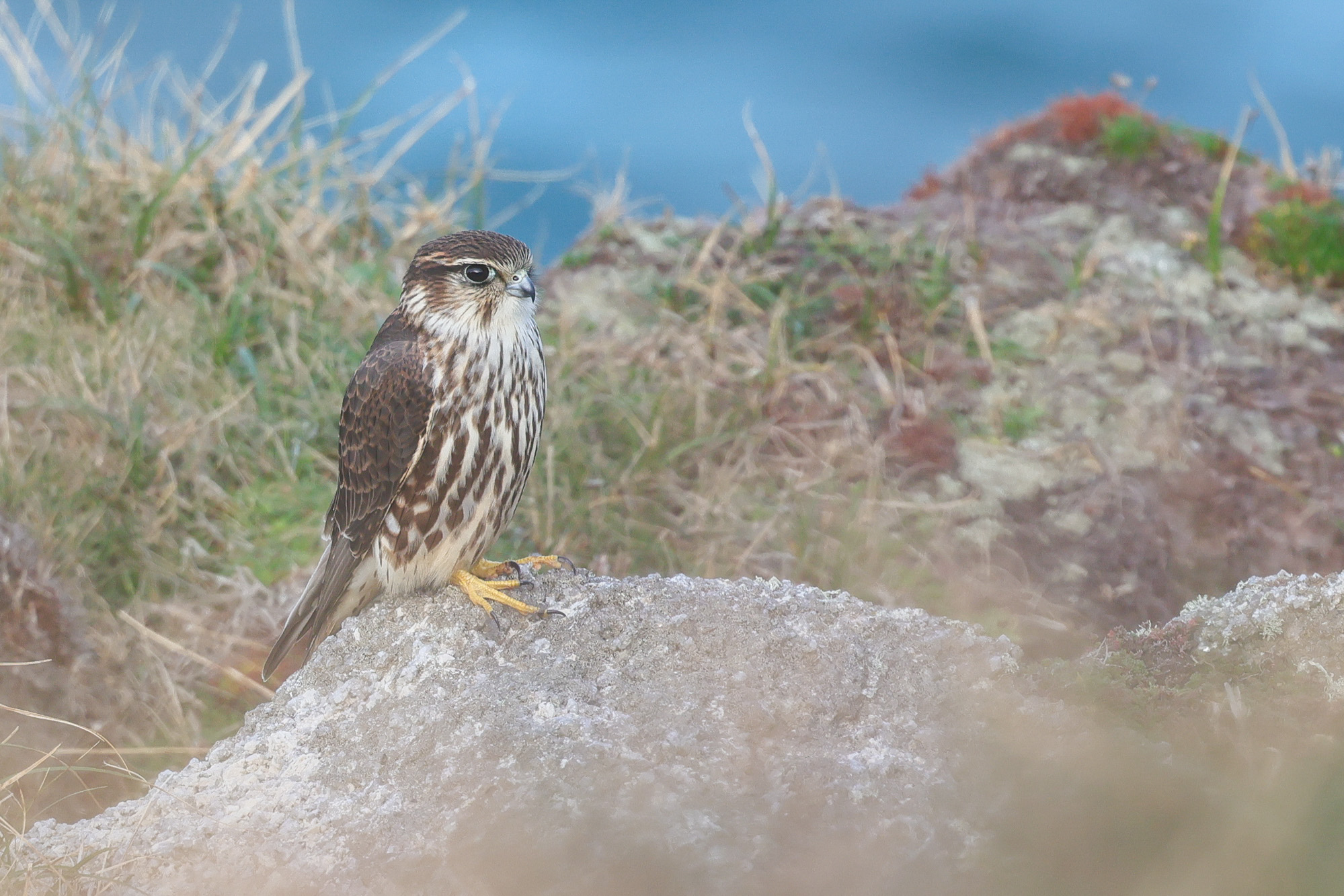 Merlin at Jenny's Cove A. Croudace
Merlin at Jenny's Cove A. Croudace
A trickle of Swallow still with between 27-53 recorded daily and a bit more movement on 17th with 124 milling or departing. Potentially our last Sand Martin was sighted on 14th and 5 House Martin were recorded on 16th and 7 on 17th.
Birding the west coast has been productive in these easterlies, with the highlighta single Yellow-browed Warbler was picked up on a rock at Pilot's Quay. Lots of Chiffchaffs were sheltering from the wind with around 30 recorded across the island on 15th and 16th and a great count of 77 on 16th. The island's first Dusky Warbler was refound on census on both 15th and 16th, although has been extremely elusive, markedly different from it's very vocal arrival on 10th. A low day of eight Blackcap on 14th rose to 46 on 16th.
Up to 11 Firecrest were recorded in this period, although almost all had moved out by 17th when numbers had shrunk to just one in Millcombe. 13 Goldcrest on 14th, around 30 on 15th and 16th, but back down to 16 on 17th. The amazing year for Treecreeper continues, with a ringed bird remaining in Millcombe as well as likely a new fourth bird on the cliffs at Jenny's Cove on 15th. Around 10 Wheatear are recorded daily, almost all on the west.
Four Black Redstart and a single Common Redstart on 14th with three Black Redstart on 16th and 17th nicely spread between North Light, South Light and the Lodge Garden. A wonderful arrival of thrushes on 14th ended up tallying 564 Redwing, 53 Song Thrush, 30 Blackbird, 22 Fieldfare and 14 Ring Ouzel. Peregrine Falcons were constantly stooping on the arriving flocks as they dropped in whilst Sparrowhawks darted amongst the vegetation. Redwing numbers have reduced to 106 on 15th, 78th on 16th and 38 on 17th. Blackbird numbers have been fairly consistent, whilst about half of the Ring Ouzel have lingered for a day or two, including one that was ringed in Millcombe. Some flocks of Starlings have been moving through, with a high count of the autumn of 221 counted on 15th.
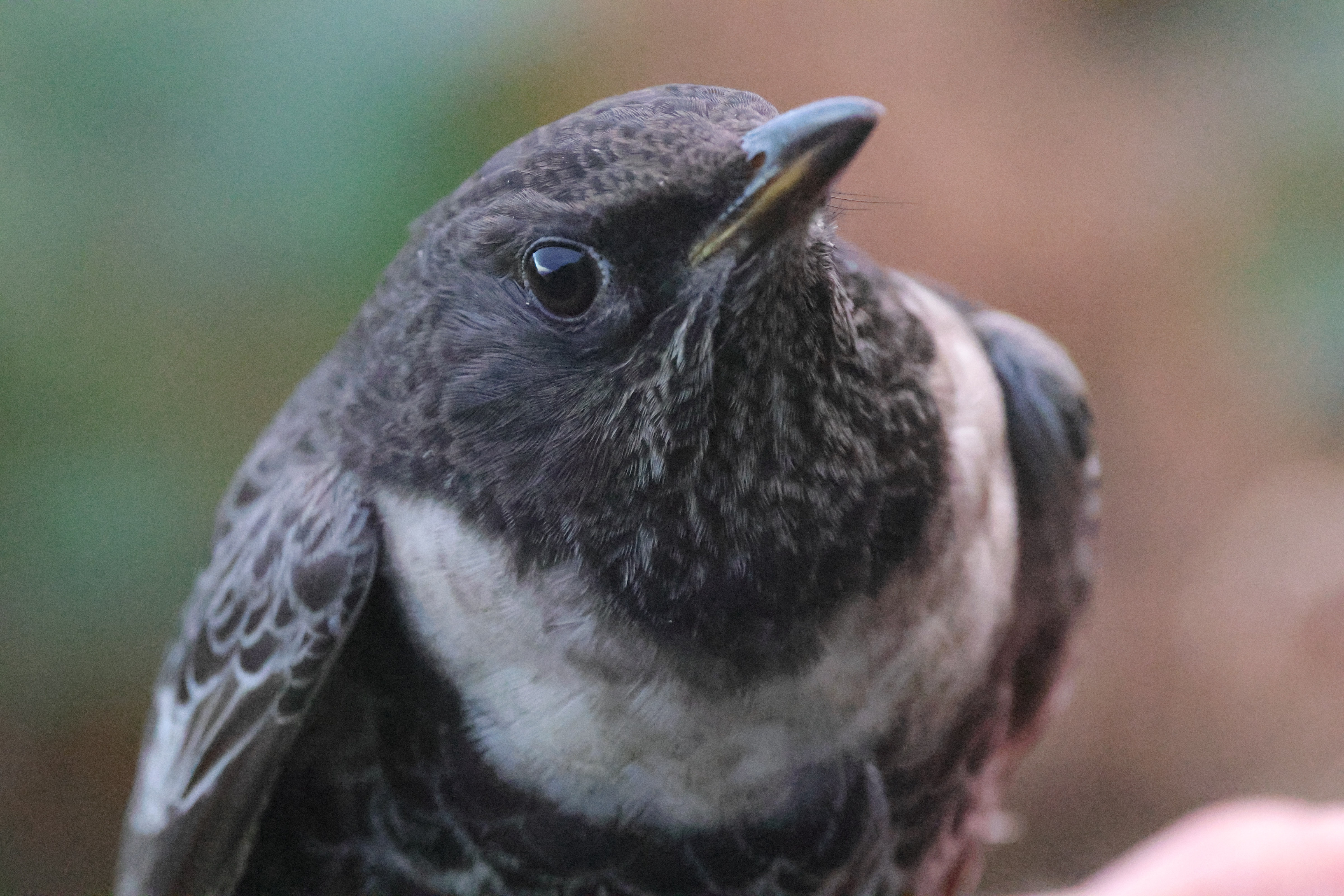 Ring Ouzel in the hand in Millcombe - A. Croudace
Ring Ouzel in the hand in Millcombe - A. Croudace
Finch migration has started with Chaffinch numbers increasing: 49 on 14th, 166 on 15th, 269 on 16th and a big day of passage on 17th with 1463. Four Redpoll on 15th and another on 16th. Brambling singles on 15th and 16th, with 10 on 17th. After a paltry Linnet count of 11 on 14th, counts have bounced back up to just under 100 and 329 on the day of big finch passage on 17th, with most bombing through heading south. 20-30 Siskins daily, and 20-78 Goldfinches.
The sixth Lundy record Olive-backed Pipit has been associating with up to 20 Rock Pipits at Jenny's Cove/Devil's Chimney since 14th, although was not seen on 17th. Interestingly a Tree/Olive-backed Pipit type call has also been heard fleetingly on three consecutive days around the village, but a bird has not been seen on the ground to confirm the species.
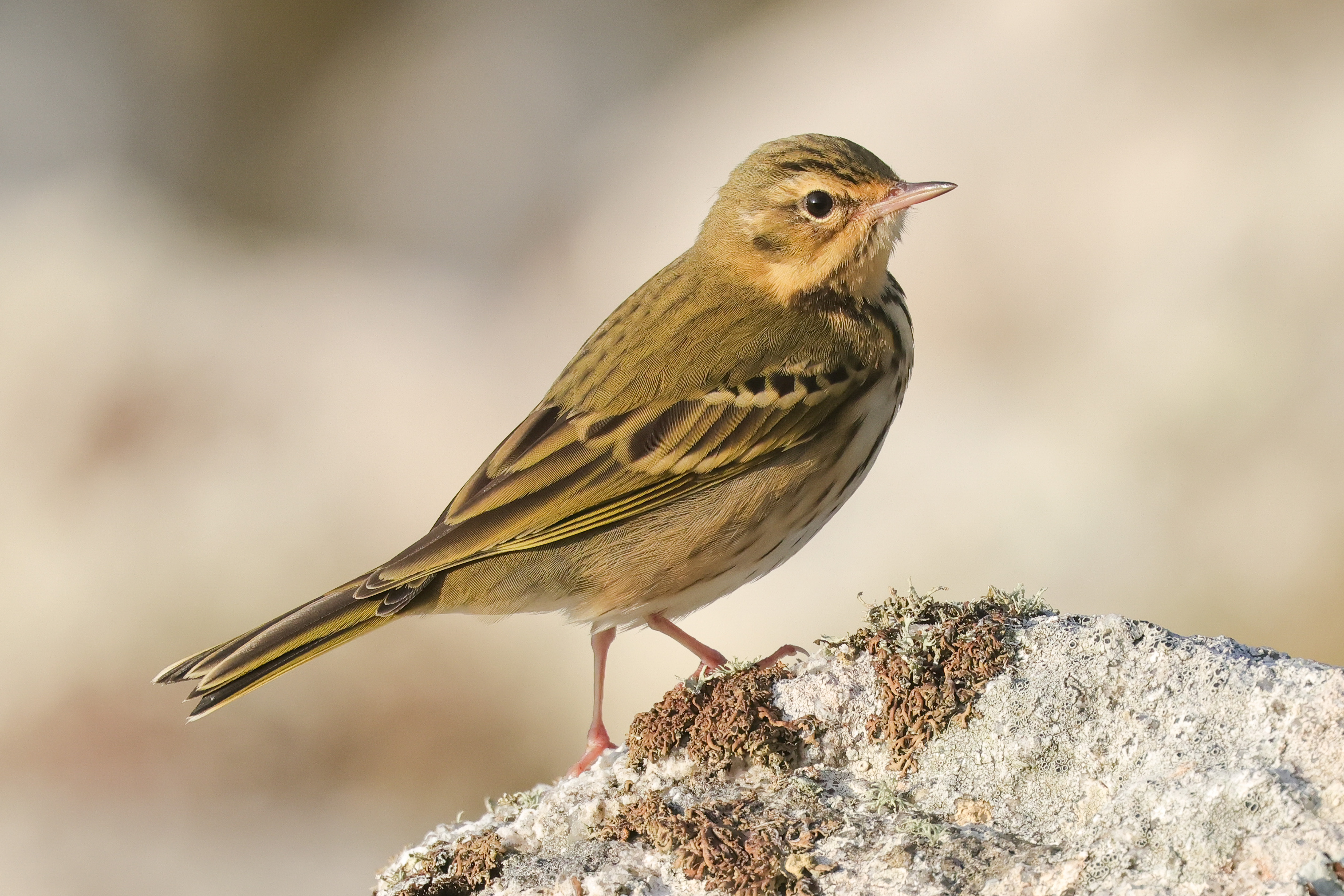 The subtle beauty of an Olive-backed Pipit above Devil's Chimney A. Croudace
The subtle beauty of an Olive-backed Pipit above Devil's Chimney A. Croudace
The single Snow Bunting was seen on the west again on 15th and 16th. Reed Buntings have become more regular, with up to three recorded daily, mostly at Pondsbury and Quarter Wall as is typical. Finally, another great bird for Lundy was a vis-mig Yellowhammer with Chaffinches over Millcbome on 17th, the ninth (and 3rd autumn) record since 2010 of this species which bred on Lundy until at least the 1950s.
11-13th October - Thrushes are here
12th and 13th brought F4-5 easterlies making birding Millcombe and the East a bit more difficult.
Great coverage of the island, in particular sheltered areas of the west coast on these days with easterlies led to some high counts of 55 Chiffchaff on 12th, including 14 at Devil's Chimney. It also turned up a Black Redstart and a single Snow Bunting near the Devil's Slide. There was also an arrival of Wheatear on 12th, with numbers back up to 11 after remaining at one or two since September 29th. A single Common Redstart was below the Terrace on 11th and at North Light on 13th and a Yellow-browed Warbler was present in Quarter Wall Copse for a second day on 11th.
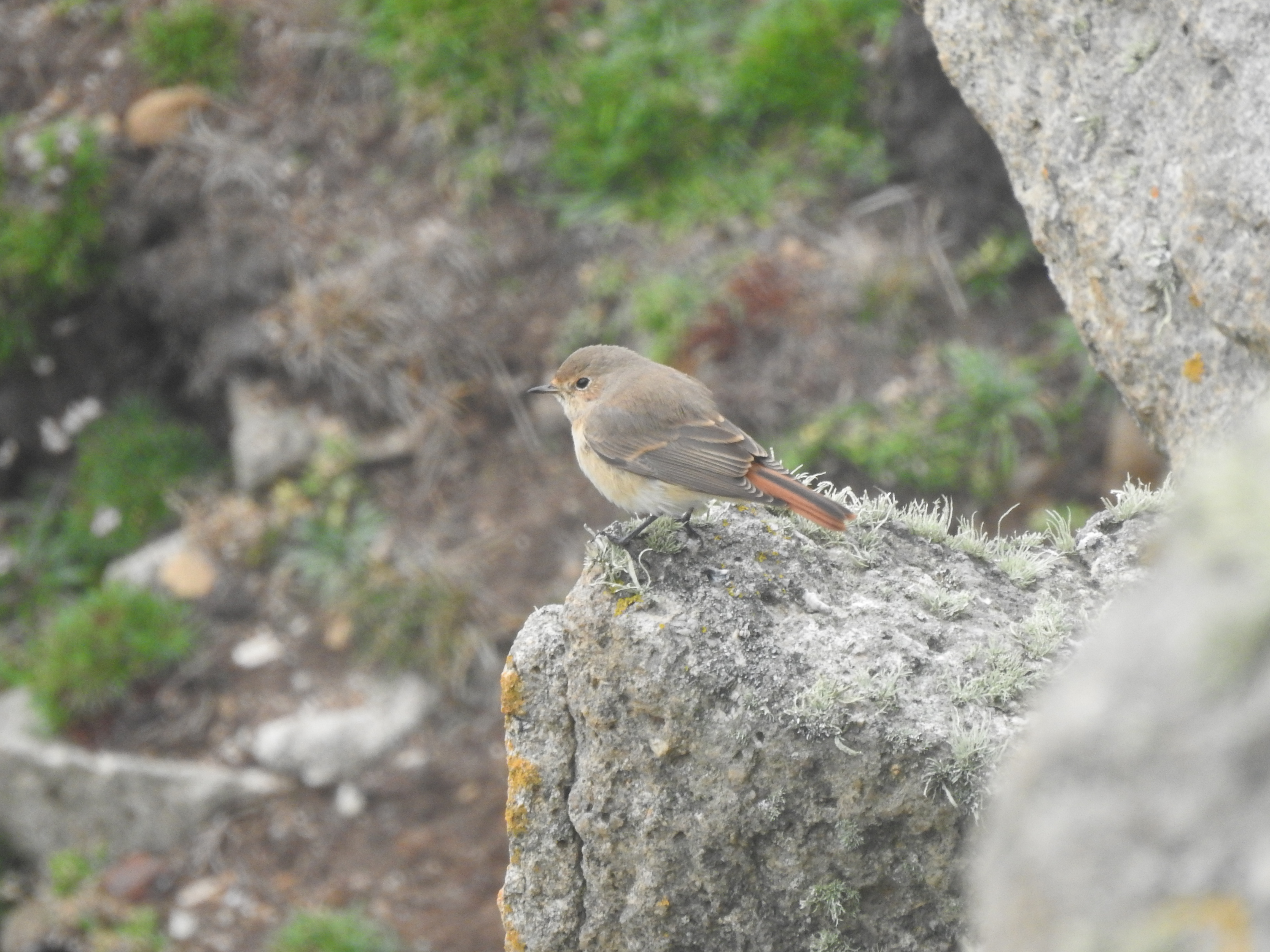 Common Redstart at North Light D. Burbidge
Common Redstart at North Light D. Burbidge
A single Curlew was seen from South Light on 12th, and there were good counts of 26 Oystercatcher on 11th and 12th. A Grey Plover was also reported on 11th, a nice bird for Lundy. Ringed Plover continues to be recorded from single flyovers. Six Snipe were recorded on the 13th. More Herring Gull have been seen lingering with counts of 47 on 11th and 63 on 12th. Fairly typical autumn counts of certain species previal including 2 Sparrowhawk (male and female), a couple of Water Rail in Millcombe, single Teal at Pondsbury, three Kestrel, seven Peregrine, and a single Merlin.
A new Great Spotted Woodpecker, the third for the autumn was in Millcombe on 12th, in a fairly notable year for this species. It was heard in Millcombe in the morning of 13th but then sadly predated remains of a Great Spotted Woodpecker were found later in the day at Gannets Coombe. In a similarly notable run of records the third Treecreeper of the autumn (all of which have been ringed) was resighted on 11th and 13th. The Rosy Starling was resighted on 11th but hasn't been seen since. A single Grey Wagtail was recorded on 11th and 12th. A single Stock Dove was photographed at Stoneycroft on 13th.
A single Song Thrush was present on 11th with 15 on 13th. After a single vanguard Redwing first thing on 12th, the 13th saw 135 Redwing and 70 Fieldfare move through, matching a clear arrival across the rest of the UK. Chaffinch numbers have started to pick up also with 10 on 11th, 29 on 12th and 53 on 13th. A lovely male Brambling was also photographed in Quarters Allotments.
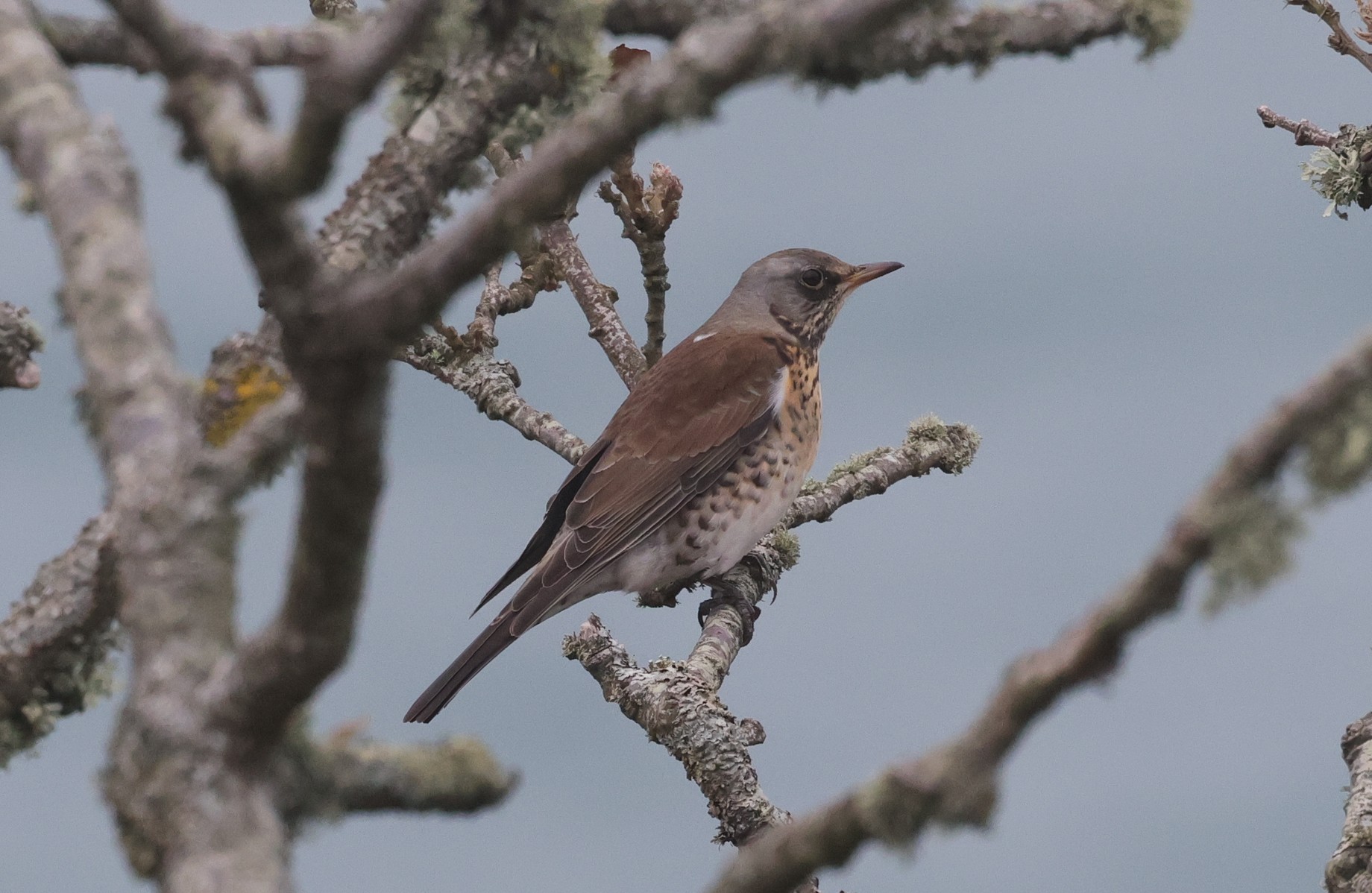
Firecrest counts were at nine on 11th, four on 12th and nine on 13th. Goldcrest counts were around 30, Blackcap counts remain around 20, Goldfinch around 50 and Siskin around 20. Swallows are the only hirundines recorded in this period with 55 on 11th, 31 on 12th and 10 on 13th. A Garden Warbler was ringed on 11th. Three Reed Bunting on 11th included a male in Millcombe and two female types at Pondsbury, and a further single on 12th.
5th-10th October – Dusky Warbler, Great White Egret and Rosy Starling
A change in wind direction and reduction in wind speeds after Storm Amy this week. A slower couple of days to start the week, picking up with a few pulses of Goldcrest, Chiffchaff and Blackcap as the week has progressed. As the winds swung northerly we welcomed a few birds from northern climes, with 2 Whooper Swans flying N over Pondsbury on 8th and 3 Snow Buntings in-off above North Light on the same day. Reed Bunting are popping up again with singles on 6th, 9th and 10th, and members of the LFS field studies group were delighted to encounter a very showy Lapland Bunting on the track at Pondsbury on 10th.
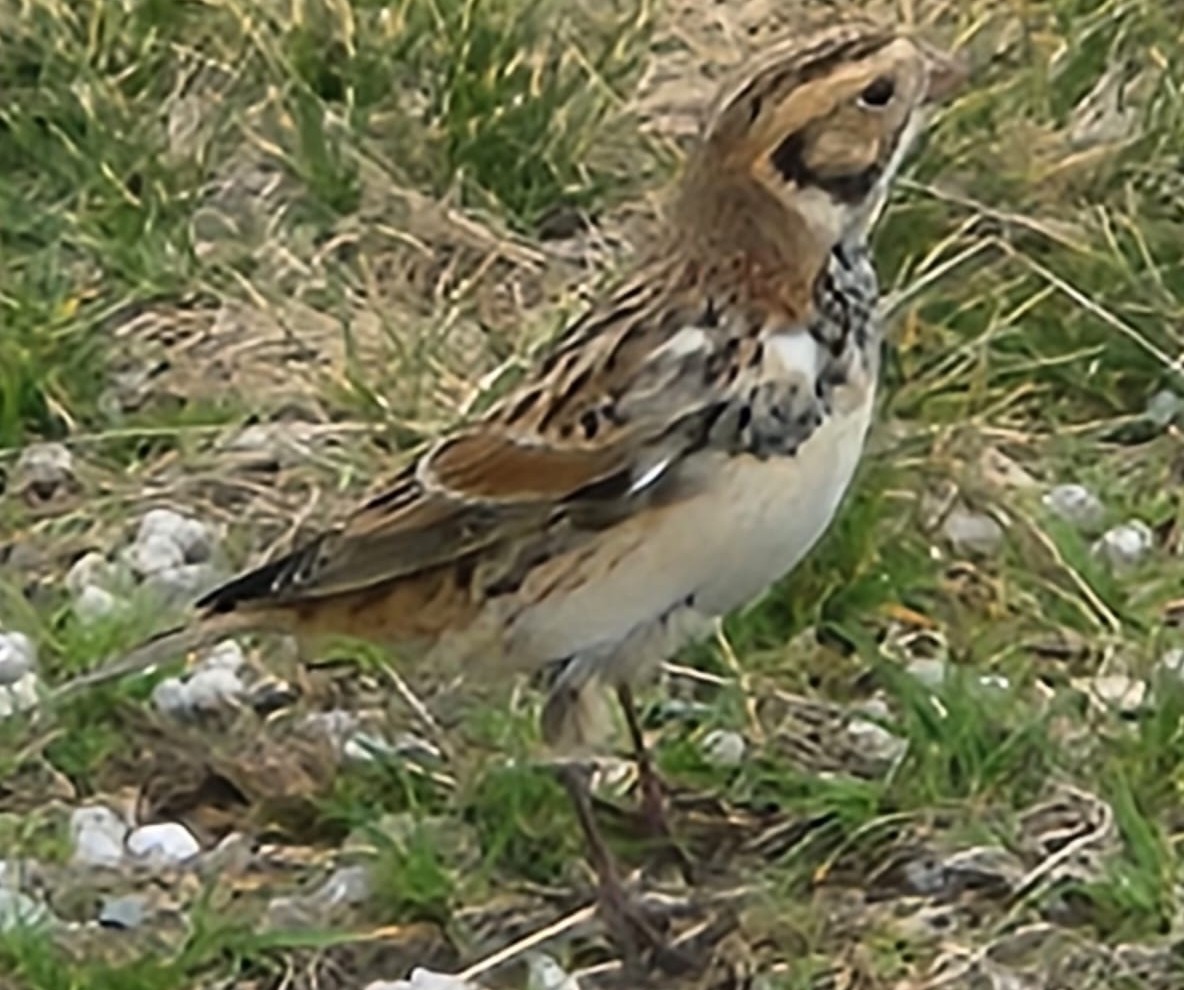 Lapland Bunting, Pondsbury - M. English
Lapland Bunting, Pondsbury - M. English
Up to three Water Rail are calling in Millcombe, with an individual heard by the terrace several times too. A single Black-headed Gull flew N from the Ugly on 5th and a Great Skua was seen from the castle heading W on 7th. Two Curlew flew NW over the Ugly on 5th and a single was heard on the 6th. A single Sanderling dropped into the track on Castle Hill on census on the 5th and was later seen at Pondsbury. It was a good day for waders, with a flock of four Redshank passing over the village. Ringed Plover singles have been recorded again daily since the 8th, and a flock of six Golden Plover on 7th flew over the village but weren't seen again. Great coverage by visiting birders saw 13 Snipe recorded on 8th.
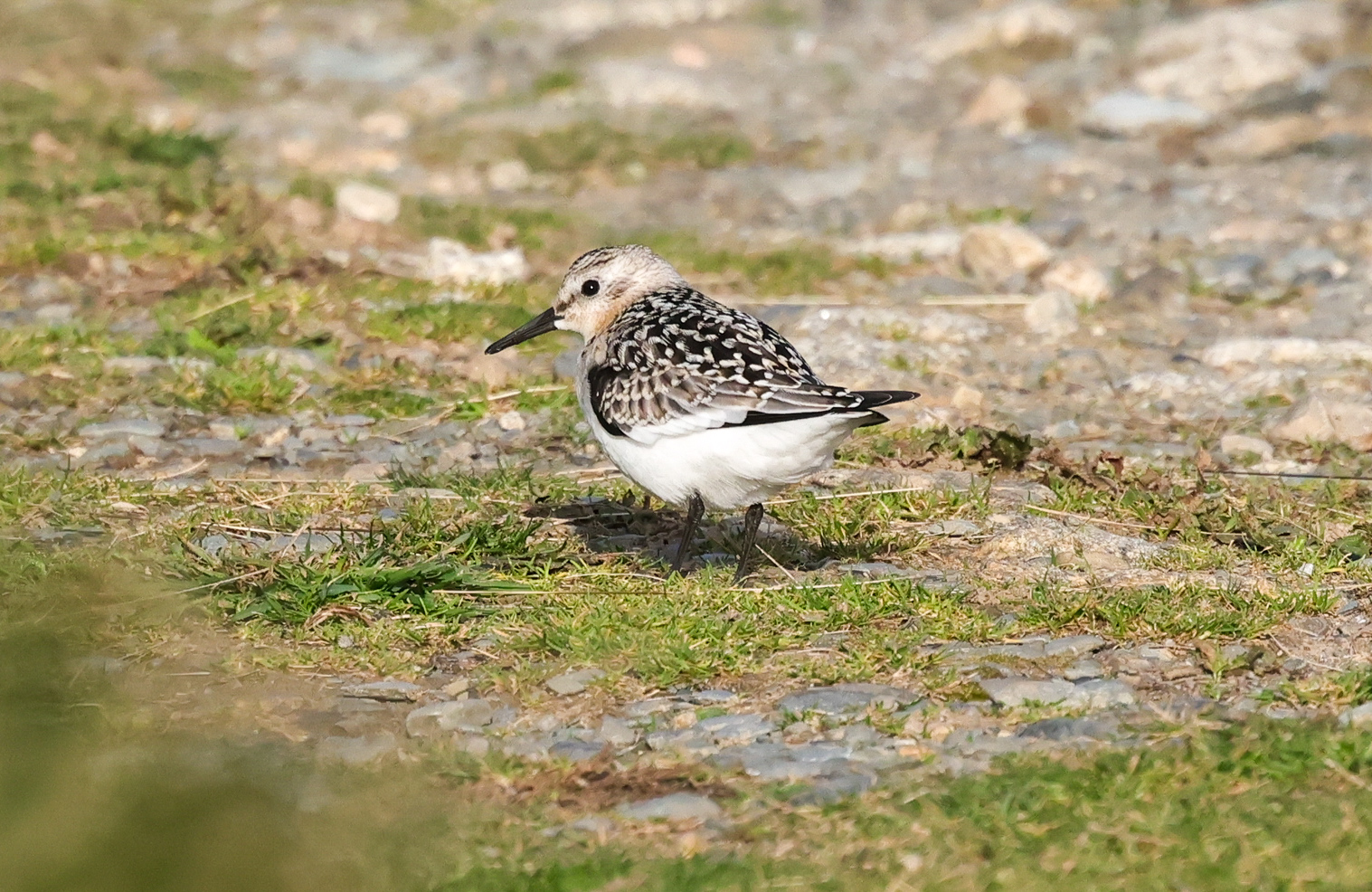 Sanderling, Castle Hill - A. Croudace
Sanderling, Castle Hill - A. Croudace
A Great White Egret, just island's sixth record after the first in 2020 was a great find when it flew over Millcombe heading NW on the 9th, seen by four observers but clearly on a mission, with no photos nor resightings. Up to three Sparrowhawk are regularly seen and finally some Merlin arrived, with three seen all over the island on 9th and two seen on 10th. With no significant thrush movement yet there's not a huge amount of prey available, and all of the pigeons have already succumbed to the Peregrine Falcons, of which up to six are recorded daily. The Peregrines have been watched hunting Linnet and Starling this week, clearly having to resort to smaller items on the menu. Hirundines are petering out with totals ranging from 43 and 178 this week, with a couple of House Martin also and a single Sand Martin.
Nice Skylark passage on 9th totalled 85 birds at log including a very high flock of 35 over Millcombe first thing, although wagtail passage has dropped off significantly, with just three Grey Wagtails and small numbers of Alba Wagtails all week. A fairly late Tree Pipit was heard over Millcombe on 9th. Our third Yellow-browed Warbler of 2025 was heard in Quarter Wall Copse on the 9th too. Our second Red-breasted Flycatcher of the autumn is favouring St Helen's Copse, present 8-10th and extremely vocal, proving very entertaining to watch. Spotted Flycatcher lingered until the 8th, and Pied Flycatcher are still dropping in, with another new bird ringed on 10th. A juvenile Common Redstart was also ringed on 10th, the only record of the month apart from two on 6th. A stunning male Black Redstart was a fairly early record, seen below the Beach Road on 5th.
Three Garden Warbler arrived with 48 Blackcap on 7th, our highest count for this week. Firecrest numbers had dwindled to one or two at the start of the week but are now bolstered back up to either birds, accompanied by around ~25-50 Goldcrest, with a peak of 87 on 9th. In an exceptional year for Treecreepers another two birds have been seen and ringed in Millcombe this week, making that three individuals thus far in 2025. A couple of long-winged migrant Chaffinches have been ringed but we are still awaiting the finch movement to start with gusto! Up to 10 Siskin have been seen on a more regularl basis this week with one Redpoll on the 9th and one Greenfinch on the 6th.
A juvenile Rose-coloured Starling was new in today, a bird that has become just about annual since 2014. Ring Ouzel singles have been recorded on the 6th (west side 3/4 wall) and 9th (south of The Ugly). A single Song Thrush was ringed in Millcombe on 10th.
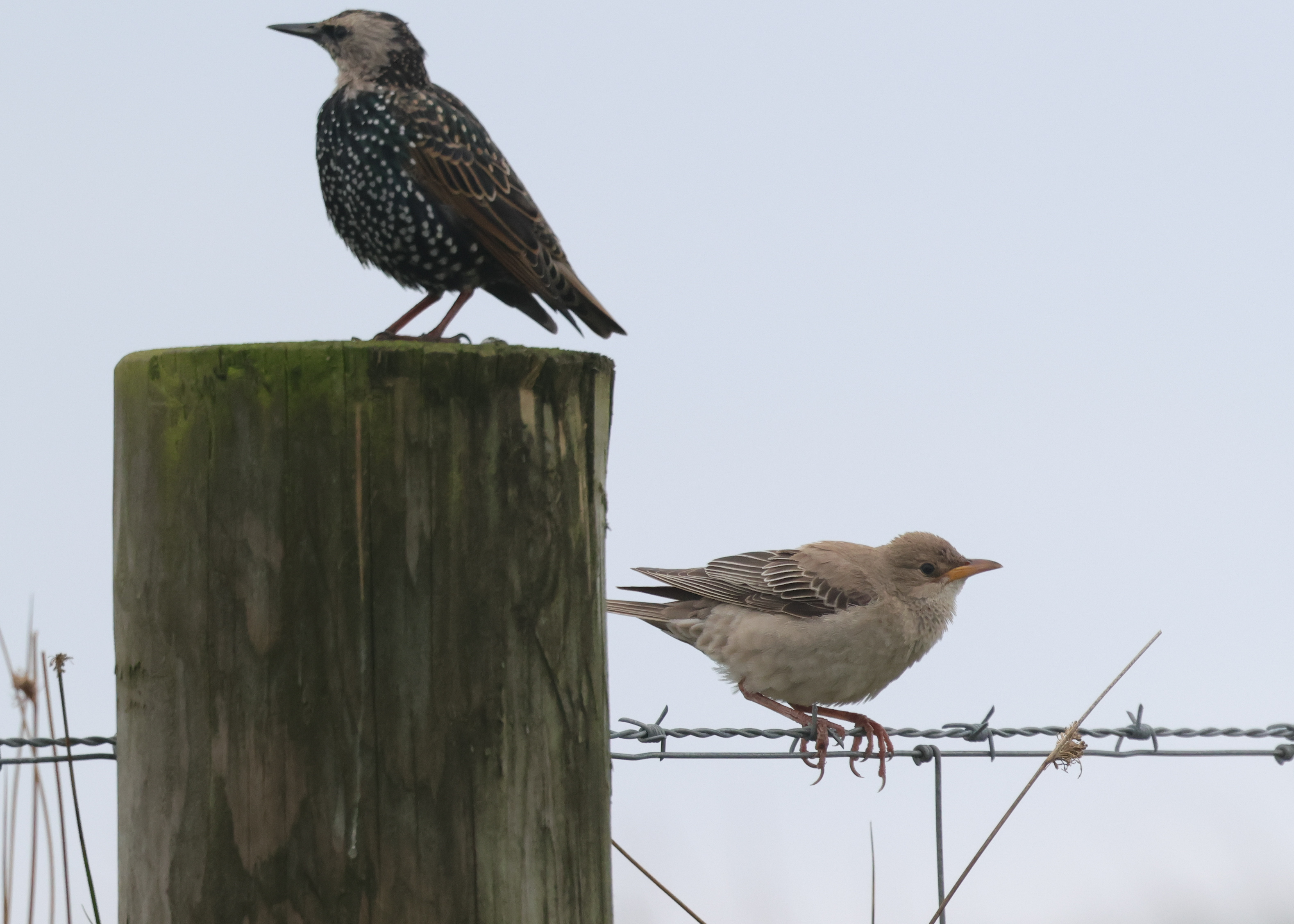 1st winter Rose-Coloured Starling by the Airfield. A. Croudace
1st winter Rose-Coloured Starling by the Airfield. A. Croudace
An overdue first for Lundy finally fell today when a DUSKY WARBLER was picked up calling vociferously on census. It was rummaging around the overgrown vegetation in Millcombe Pond before briefly bursting out of cover onto some brambles where it allowed a brief but good look plus a record shot. The bird was followed as it worked its way up the Millcombe allotments, starting on the ground before moving on some higher vegetation. It was then lost just below slope net, but turned up minutes later in the next net round in secret garden! It was resighted later in the morning very briefely after ringing, skulking in vegetation above the Gas Shed.
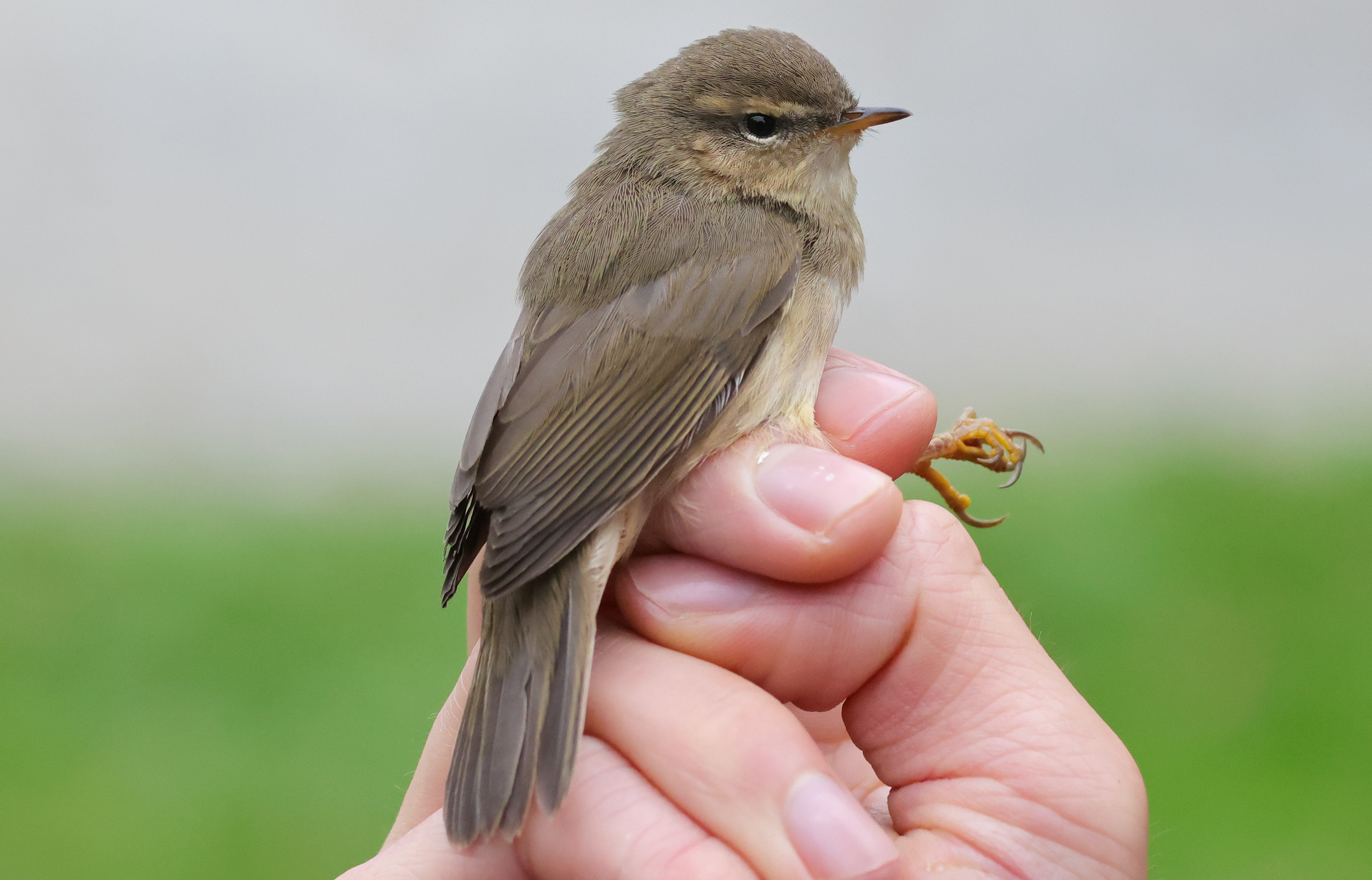 Dusky Warbler in the hand. A Croudace
Dusky Warbler in the hand. A Croudace








